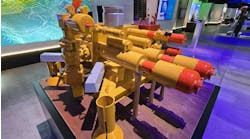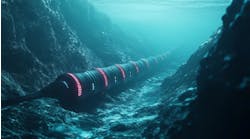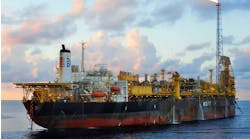Hydro plans Oseberg Delta
Hydro has submitted its plan for development and operation of the satellite field Oseberg Delta in the North Sea to the Norwegian Ministry of Oil and Energy with production start scheduled for Oct. 1, 2007, and has begun awarding contracts associated for the field’s development.
Oseberg Delta will be developed as an underwater installation of one wellhead template with four drilling slots connected to the Oseberg D platform at the Oseberg field center about 8.5 km away with two 10-in. pipelines.
Hydro has awarded a Nkr160-million contract for supply of underwater production systems for Oseberg Delta to FMC Kongsberg Subsea AS.
The contract covers procurement and construction work, including planning, procurement, fabrication, and testing of two wellhead systems, two horizontal subsea trees, control systems, and a template manifold. The production unit will be built with space for four subsea wellhead trees and the option to connect a satellite structure.
The Oseberg field includes three platforms, Oseberg A, B and D, connected to one another with bridges, in the south part of the Oseberg field, and the Oseberg C platform, which lies 14 km north of Oseberg A, B, and D (collectively referred to as the Oseberg Field Center).
FMC says planning work, procurement, fabrication, and testing will take place in 2005 and 2006. The base frame and manifold are planned to be installed in the field during the summer of 2006, and the wellhead tree system is planned to be delivered in the fall of the same year.
The contract is based on Hydro’s frame agreement with FMC Kongsberg Subsea for the delivery of underwater equipment.
“Oseberg Delta will be a major contribution to the further development of the Oseberg area,” says Jan Arve Haugan, director of the Oseberg/Grane unit in Oil & Energy.
The production stream will be directed to the same receptor used for the Tune satellite field. The existing receptor facility for Tune is to be modified to handle production from Oseberg Delta.
Estimates for recoverable gas from Oseberg Delta are 8 bcm. In addition, it has been calculated that the field contains 2.7 bcm of oil and condensates. Production from Oseberg Delta will increase gradually as production from Tune declines. At its peak, Delta will produce 5 MMcm/d of gas. It is expected that Oseberg Delta will remain in production until 2014.
Hydro estimates the development of Oseberg Delta, situated in 102-m water depth, will cost Nkr 1.8 billion, including the drilling of two wells. The wells will be drilled in the winter of 2006/2007. Delta is considering development of several new opportunities in the area, such as the “G-central” prospect.
“Oseberg Delta is a building block that makes it possible to include production from other seabed structures nearby,” says Tore Grønvold, project manager for Oseberg Delta PUD.
Hydro says the development plan for this field is the last milestone for the time being in Hydro’s long-term work to develop the Oseberg area. Production from the satellite field J-structure at Oseberg South began in June. Work on the Oseberg West Flnak is continuing at full pace, and production will begin this December.
Hydro expects the ministry will respond to the application for development in September.
Oseberg Delta operator Hydro has 34%, Petoro AS with 33.6%, Statoil ASA with 15.3%, Total E&P Norge with 10%, Exxon Mobil Production Norway Inc with 4.7%, and Norske Conoco Phillips with 2.4%.
Kerr-McGee to develop East Breaks 599
null
Kerr-McGee Corp. plans to develop its East Breaks block 599 discovery in the Gulf of Mexico via a subsea tieback to its Boomvang production hub 3 mi away on East Breaks 643.
Kerr McGee estimates the field’s potential resources at 10 MMboe to 20 MMboe. East Breaks 599 is located in 3,220 ft of water. The East Breaks 599 well, spuded on May 27, was drilled to 9,142 ft MD and encountered more than 135 net ft of high-quality oil pay in several sands. The well will be temporarily abandoned for completion in early 2006.
“Our deepwater hub-and-spoke strategy for developing core areas continues to add value through satellite successes such as the East Breaks 599 discovery,” said Dave Hager, Kerr-McGee senior vice president responsible for oil and gas exploration and production. “We plan additional satellite exploration in the East Breaks area, with a four-well exploratory program at Northwest Nansen near our Nansen production hub. We expect to spud the first well later this summer and estimate that the combined resource potential for the four fault blocks is in the range of 20 MMboe to 50 MMboe.”
Operator Kerr-McGee holds 33.34%, Amerada Hess Corp. holds 33.33% and Marubeni Oil & Gas (USA) Inc. holds 33.33% interest.
Statoil plans subsea templates for Tyrihans
null
Statoil has submitted a development and operation plan featuring five subsea templates for Tyrihans in the Norwegian Sea to the Ministry of Petroleum and Energy.
The oil and gas field will be developed with five subsea templates, including one for seawater injection. Wellstream processing will be on Statoil’s Kristin platform. Tyrihans is scheduled to come onstream in 2009, when spare capacity will be available on the Kristin installation.
“This field calls for extensive technology development, but the work still needing to be done is felt to be at an acceptable level,” says Ståle Gjersvold, project manager for Tyrihans.
Pressure support will be ensured by injecting gas from Statoil’s Åsgard development to supplement the template dedicated to seawater injection.
“Extensive use will be made of multilateral wells,” Gjersvold says. “We’ll also be advancing our smart well technology to improve recovery from subsea-developed fields.”
Gas from Tyrihans will be exported via Kristin and the Åsgard Transport trunkline to Kårstø north of Stavanger, while oil and condensate are stored on the Åsgard C vessel for export by ship. Tyrihans is expected to yield recoverable reserves of about 182 MMbbl of oil and condensate and 34.8 bcm of rich gas.
The Tyrihans templates will lie in roughly 300 m of water about 35 km southeast of the Kristin platform. A 43-km pipeline linking these structures with Kristin will be electrically heated to inhibit hydrate formation. The development plan includes 12 wells, including nine for production, two for gas injection, and one for injecting unprocessed seawater.
“This project combines all our knowledge and innovative technology for improved recovery from subsea-developed fields,” Gjersvold says. “It will set a new standard from bringing such developments onstream.”
Total development costs are estimated to be just under NKr 14 billion.
TheTransocean Arctic rig has been chartered for drilling and completion work.
Operator Statoil has 46.8%, Total has 26.5%, Norsk Hydro has 12%, Eni Norge has 7.9%, and ExxonMobil has 6.75%.•




